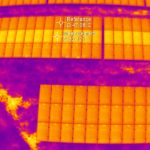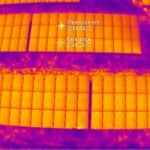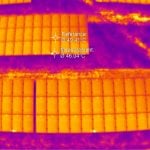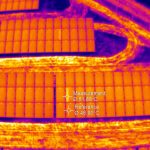Commercial Solar Maintenance
FlyThru prides itself on the expertise of its solar maintenance personnel, and having successfully inspected and reported on 150 MW of solar installation over 180 days it is amongst the most experienced solar maintenance firm in the UK.
Inspections have been conducted on sites ranging from 1 MW sites to 70 MW megafarms, however the majority of surveys have been conducted on typical 5 – 10 MW solar installations. In the summer of 2017, a thermal drone survey was conducted by FlyThru on a typical 5 MW UK site with a total of 90 individual faults being located. To locate faults, a UAV was flown up and down the solar PV array whilst gathering data with a thermal imager. With a thermal sensitivity of 0.04 K and field of view of 38°, this system has the ability to detect any notable fault that can occur on a solar installation, including:
- Single hotspot
- Multiple hotspots
- Heated substring / diode faults
- Vegetation covering
- String faults
- Inverter faults
- Patchwork
- Shading from trees / powerlines etc
Following site work, the data from this project was then analysed by a fully qualified FlyThru renewable energy engineer and a full site maintenance report produced. The items highlighted in bold above are the faults found on this particular site. FlyThru delivers a full site fault map on such projects, so clients can swiftly locate faults and rectify any found issues. Of the 90 faults found on this particular project, four string faults were identified. In total, 88 panels were affected by these string faults and were not conducting any power. Thanks to a swift turn around on data collection and analysis, the site manager was able to quickly identify the electrical connection faults creating the detected string faults and return the panels to power generation, saving the farm potentially thousands of pounds in lost revenue.
Below are images of each fault type located at this site (string fault, vegetation covering, hotspots & heated substrings/diode faults, respectively), as well as an example of part of a FlyThru fault map diagram.




